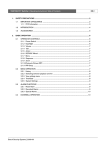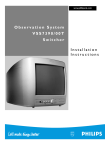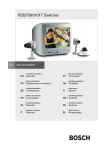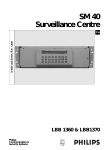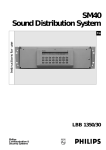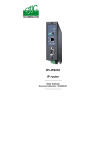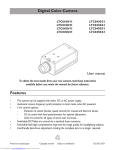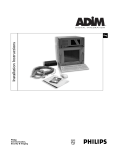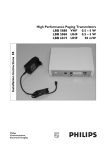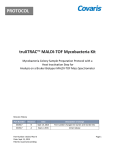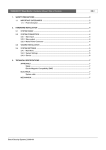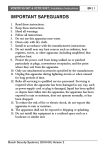Download Bosch VSS7390/01T Specifications
Transcript
www.philipscsi.com Observation System VSS7390/00T Switcher Installation Instructions Page English ........................................................................................................................................3 French........................................................................................................................................15 German ....................................................................................................................................27 Spanish ......................................................................................................................................39 Dutch ........................................................................................................................................51 Italian..........................................................................................................................................63 Portuguese................................................................................................................................75 Danish........................................................................................................................................87 Finnish........................................................................................................................................99 Norwegian................................................................................................................................111 Swedish......................................................................................................................................123 Greek ........................................................................................................................................135 2 P H I L I P S O B S E RVAT I O N S YS T E M VSS7390/00T SWITCHER CONTENTS SECTION 1 GENERAL 1 SAFETY PRECAUTIONS . . . . . . . . . . . . . . . . . . . . . . . . . . . . . . . . . . . . . . . . . .4 1.1 IMPORTANT SAFEGUARDS VENTILATION . . . . . . . . . . CLEANING . . . . . . . . . . . . DISPOSAL . . . . . . . . . . . . . 1.1.1 FCC Information . . . . . . . . . . . . . . . . . . . . . . . . . . . . . . . . . . . . . . . . . . . . . . . . . . . . . . . . . . . . . . . . . . . . . . . . . . . . . . . . . . . . . . . . . . . . . . . . . . . . . . . . . . . . . . . . . . . . . . . . . . . . . . . . . . . . . . . . . . . . . . . . . . . . . . . . . . . . . . . . . . . . . . . . . . . . . . . . . . . . . . . . . . . . . . . . . . . . . . . . . . . . . . . . . . . . . . . . . . . . . . . . . . . . . . . . . . . . . . .4 . . . . . . .4 . . . . . . .4 . . . . . . .4 . . . . . . .4 SECTION 2 INSTALLATION 2 HARDWARE INSTALLATION 2.1 2.2 2.2.1 2.2.2 2.2.3 2.2.4 2.2.5 2.2.6 2.2.7 2.3 2.4 2.4.1 2.4.2 2.4.3 2.4.4 2.4.5 2.4.6 2.4.7 2.4.8 2.4.9 2.4.10 System cable . . . . . . . . . . . . . . . . . . . . . . . . . . . . . . . . . . . . . . . . . . . . . . . . . . . . . . . . . . . . . . . .5 SYSTEM CONNECTION . . . . . . . . . . . . . . . . . . . . . . . . . . . . . . . . . . . . . . . . . . . . . . . . . . . . . .5 Camera inputs (1 to 4) . . . . . . . . . . . . . . . . . . . . . . . . . . . . . . . . . . . . . . . . . . . . . . . . . . . . . . . . . . .5 Slave output . . . . . . . . . . . . . . . . . . . . . . . . . . . . . . . . . . . . . . . . . . . . . . . . . . . . . . . . . . . . . . . . . . .5 Aux. output/input . . . . . . . . . . . . . . . . . . . . . . . . . . . . . . . . . . . . . . . . . . . . . . . . . . . . . . . . . . . . . . . .5 VCR in/output . . . . . . . . . . . . . . . . . . . . . . . . . . . . . . . . . . . . . . . . . . . . . . . . . . . . . . . . . . . . . . . . . .6 Alarm output contact (N.O./N.C.) . . . . . . . . . . . . . . . . . . . . . . . . . . . . . . . . . . . . . . . . . . . . . . . . . . . .6 RS232 . . . . . . . . . . . . . . . . . . . . . . . . . . . . . . . . . . . . . . . . . . . . . . . . . . . . . . . . . . . . . . . . . . . . . . . .6 Mains Power Connector . . . . . . . . . . . . . . . . . . . . . . . . . . . . . . . . . . . . . . . . . . . . . . . . . . . . . . . . . . .6 WIZARD INSTALLATION . . . . . . . . . . . . . . . . . . . . . . . . . . . . . . . . . . . . . . . . . . . . . . . . . . . . .6 SYSTEM SETTINGS . . . . . . . . . . . . . . . . . . . . . . . . . . . . . . . . . . . . . . . . . . . . . . . . . . . . . . . . . .7 Main Menu . . . . . . . . . . . . . . . . . . . . . . . . . . . . . . . . . . . . . . . . . . . . . . . . . . . . . . . . . . . . . . . . . . . .7 System Settings Menu . . . . . . . . . . . . . . . . . . . . . . . . . . . . . . . . . . . . . . . . . . . . . . . . . . . . . . . . . . . .7 Sequence . . . . . . . . . . . . . . . . . . . . . . . . . . . . . . . . . . . . . . . . . . . . . . . . . . . . . . . . . . . . . . . . . . . . . .7 Alarms . . . . . . . . . . . . . . . . . . . . . . . . . . . . . . . . . . . . . . . . . . . . . . . . . . . . . . . . . . . . . . . . . . . . . . . .7 Aux output . . . . . . . . . . . . . . . . . . . . . . . . . . . . . . . . . . . . . . . . . . . . . . . . . . . . . . . . . . . . . . . . . . . .8 VCR . . . . . . . . . . . . . . . . . . . . . . . . . . . . . . . . . . . . . . . . . . . . . . . . . . . . . . . . . . . . . . . . . . . . . . . . .9 Installation . . . . . . . . . . . . . . . . . . . . . . . . . . . . . . . . . . . . . . . . . . . . . . . . . . . . . . . . . . . . . . . . . . . . .9 Motion Sensitivity . . . . . . . . . . . . . . . . . . . . . . . . . . . . . . . . . . . . . . . . . . . . . . . . . . . . . . . . . . . . . . .10 Service . . . . . . . . . . . . . . . . . . . . . . . . . . . . . . . . . . . . . . . . . . . . . . . . . . . . . . . . . . . . . . . . . . . . . . .11 Disable System Setting Option . . . . . . . . . . . . . . . . . . . . . . . . . . . . . . . . . . . . . . . . . . . . . . . . . . . . .11 . . . . . . . . . . . . . . . . . . . . . . . . . . . . . . . . . . . . .5 Menu structure . . . . . . . . . . . . . . . . . . . . . . . . . . . . . . . . . . . . . . . . . . . . . . . . .12 SECTION 3 TECHNICAL SPECIFICATIONS ELECTRICAL . . . . . . . . . . . . . . . . . . . . . . . . . . . . . . . . . . . . . . . . . . . . . . . . . . . . . . . . . . . . . . . . . . . .13 MECHANICAL . . . . . . . . . . . . . . . . . . . . . . . . . . . . . . . . . . . . . . . . . . . . . . . . . . . . . . . . . . . . . . . . . .13 3 Contents P H I L I P S O B S E RVAT I O N S YS T E M VSS7390/00T SWITCHER SECTION 1 GENERAL 1 VENTILATION SAFETY PRECAUTIONS 20. Keep ventilation openings free to avoid the monitor for overheating. 21. Do not place the monitor in the immediate vicinity of a heating source. 22. Do not install this equipment in a confined space such as a bookcase or similar unit. CLEANING 23. You can clean the monitor with a moist fluff-free cloth or shammy leather 1.1 IMPORTANT SAFEGUARDS cloth. 1. Read these instructions. DISPOSAL 2. Keep these instructions. 24. This monitor contains batteries. Do not dispose of these batteries with 3. Comply with all warnings. other solid waste. The batteries type AA (standard penlights) are located in 4. Follow all instructions. the battery compartment at the bottom of your monitor. 5. Do not use this equipment near water. 6. Clean only with dry cloth. 7. Do not block any ventilation openings. Install in accordance with the manufacturer’s instructions. Remark: Philips has a strong commitment towards the environment. This monitor 8. Do not install near any heat sources such as radiators, heat registers, stoves, has been designed to respect the environment as much as possible. CAUTION: Danger of explosion if batteries are incorrectly replaced. Replace only with the same or equivalent type. or other equipment (including amplifiers) that produce heat. 9. Note: Any change or modification not expressly approved by Philips of the Do not defeat the safety purpose of the polarized or grounding-type plug. equipment authorization could void the user's authority to operate the A polarized plug has two blades with one wider than the other. A equipment. grounding type plug has two blades and a third grounding prong. Both the wide blade and the third prong are provided for your safety. If the For additional information or to speak to a representative, please contact the provided plug does not fit into your outlet, consult an electrician for Philips Communication, Security & Imaging location nearest you or visit our replacement of the obsolete outlet. web site at www.Philipscsi.com. 10. Protect the power cord from being walked on or pinched particularly at (See: Your Guide to Observation) plugs, convenience receptacles, and the point where they exit from the equipment. 11. Only use attachments/accessories specified by the manufacturer. 12. Unplug this equipment during lightning storms or when unused for long periods of time. 13. Refer all servicing to qualified service personnel. Servicing is required when the equipment has been damaged in any way, such as power-supply cord or plug is damaged, liquid has been spilled or objects have fallen into the equipment, the equipment has been exposed to rain or moisture, does not operate normally, or has been dropped. 14. To reduce the risk of fire or electric shock, do not expose this equipment to rain or moisture. 15. The equipment shall not be exposed to dripping or splashing and that no objects filled with liquids, such as vases, shall be placed on the equipment. 16. The back of the monitor should only be removed by qualified maintenance and service personnel. 17. The lightning flash with arrowhead symbol, within a triangle, is intended to alert the user to the presence of uninstalled “dangerous voltage” within the product's enclosure; that may be of sufficient magnitude to constitute a risk of electric shock to persons. 18. Caution: to reduce the risk of electric shock, do not remove cover (or back). No user serviceable parts inside. Refer servicing to qualified service personnel. 19. The exclamation mark within a triangle is intended to alert the user to the presence of important operating and maintenance (servicing) instructions in the literature accompanying the appliance. 4 Section 1 - General P H I L I P S O B S E RVAT I O N S YS T E M VSS7390/00T SWITCHER SECTION 2 I N S TA L L AT I O N 2 HARDWARE INSTALLATION 2.2 2.2.1 Camera inputs (1 to 4) This chapter describes the installation of the system hardware. For details of operation, see the supplied Operation Instructions. The cameras are connected to inputs 1 through to 4, depending on the number of cameras used. Note: Ensure that you read all safety precautions. 2.1 SYSTEM CONNECTION 2.2.2 Slave output An output for a slave monitor (optional accessory) is available. This output can also be used to connect an optional Network Observation System. SYSTEM CABLE For the interconnection between the monitor and camera a 15m/45ft system cable is supplied with the camera. For an optimum picture and sound quality you should always use 4-wire dual twisted-pair cable when extending the connection. The maximum allowed cable length is 200m/600ft. Pay attention that the connectors are fixed to the cable corresponding to the figure below. (Figure 3.1) If the length of the system cable is over 200m/600ft (up to 300m/900ft), an interface box should be used to feed the accessory or camera (see optional accessories in the Operation Instructions). 2.2.3 Aux. output/input You can configure an auxiliary output configuration via the menu option (see System settings). The auxiliary output provides loop-through from one of the 4 camera inputs or presentation mode where you can connect another video source to aux-in. It is possible to switch between this video source and one of the camera pictures. Note: The supplied A/V cable can be used for Aux. output/input connection. However, if you are using two VCRs, you will need to order a second A/V cable (see your local supplier). Caution: The plugs used for the observation system have the same dimensions as standard telephone plugs. (RJ-11) Never connect telephone equipment or cable to the observation system. n Connect the Mini Din plug to the Aux. connector of the system monitor. CAMERA 1..4 VCR (PLAYBACK ONLY) VIDEO IN AUDIO IN VIDEO OUT AUDIO OUT Not used TV / MONITOR VIDEO OUT AUDIO OUT VIDEO IN AUDIO IN TO SLAVE Time Lapse VCR VIDEO IN VIDEO OUT VIDEO OUT VIDEO IN NOT USED 1 2 3 AUDIO IN AUDIO OUT AUDIO OUT AUDIO IN 4 ALARM System Connection 5 Section 2 - Installation P H I L I P S O B S E RVAT I O N S YS T E M n Connect the BNC connectors to the video in and video output of the VCR or CVBS monitor. n Connect the RCA plugs to the Audio in and Audio out of your VCR or CVBS monitor. VSS7390/00T SWITCHER 2.3 When the system is powered up the FIRST time, the WIZARD setup option is displayed. The Installation Wizard will guide you through the most important settings of the system. Follow the screen options and select using the ROTARY wheel. 2.2.4 VCR in/output The VCR in/output allows you to connect a VCR to record camera images. n Connect the Mini Din plug to the VCR connector of the system monitor. n Connect the BNC connectors to the video in and video output of the VCR. WIZARD INSTALLATION Note: When an additional camera or accessory is connected to the system, the WIZARD function is automatically enabled and you are guided through the appropriate menus at power up. During startup the following screen is displayed: PHILIPS O B S E RVAT I O N S Y S T E M Attention: The ‘Video In plug’ of the A/V cable must be connected to the ‘Video out’ of the VCR. The ‘Video Out plug’ of the A/V cable must be connected to the ‘Video In’ of the VCR. n VERSION x.x Connect the RCA connectors to the Audio in and Audio out of your VCR. The following menu is displayed after a number of seconds: Attention: The ‘Audio In plug’ of the A/V cable must be connected to the ‘Audio out’ of the VCR. The ‘Audio Out plug’ of the A/V cable must be connected to the ‘Audio In’ of the VCR. LANGUAGE ENGLISH FRANCAIS DEUTCH I TA L I A N O 2.2.5 Alarm output contact (N.O./N.C.) P O RT U G U E S ESPAGNOL NEDERLANDS In case of an alarm a potential free relay contact (Normally Open/Normally Closed; 24V/2A max.) can activate a VCR, siren or telephone selector. If the ‘alarm output’ is connected to the ‘alarm input’ of a video recorder, the recording speed will switch from timelapse to normal speed in case of an alarm. This will result in the recording of more pictures per second. If the alarm is acknowledged by the user or automatically after 30 seconds the VCR switches back to time-lapse mode. Turn the ROTARY wheel until the required language is highlighted. n Select your preferred language by pressing the ROTARY wheel. The following menu is displayed: C O N F I G U R AT I O N S TA RT I N S TA L L AT I O N W I Z A R D ? 2.2.6 RS232 For service purposes to connect a PC/Laptop to install/configure the observation System. YES NO 2.2.7 Mains Power Connector Ensure that you observe all safety precautions when connecting the mains power cable and switching on the power. Attention: When the configuration is changed, the system must be scanned again. Therefore always switch off the system before a camera or accessory is added or removed. After power up the system monitor will recognize the item that was added or removed. n Select YES to start the wizard setup. The wizard setup enables you to configure the system to your own settings and guides you through the process automatically. n Select NO to enable the system to automatically configure itself to the factory default settings. Note: For detailed information on the on screen menus refer to the System Settings Part. 6 Section 2 - Installation P H I L I P S O B S E RVAT I O N S YS T E M VSS7390/00T SWITCHER When completed the following screen will appear: 2.4.3 Sequence You can change the sequence dwell time from 02 sec to 30 secs. Sequence/dwell time is the length of time an image is displayed before the next image in the sequence is shown. C O N F I G U R AT I O N C O N F I G U R AT I O N W I Z A R D COMPLETED 2.4 SYSTEM SETTINGS MAIN MENU SYSTEM SETTINGS The system settings that can be configured to your own requirements. The system is setup via on-screen menus. To access the menu options: n SEQUENCE DWELL TIME The ROTARY wheel controls the menu navigation as described in the Operation Instructions. The Alarm Profiles can be accessed from the Alarm menu. MAIN MENU SYSTEM SETTINGS 2.4.1 Main Menu After pressing the menu button the following menu will be displayed: ALARMS A L A R M D U R AT I O N A L A R M P RO F I L E DAY MENU SWITCH TO H I S TO RY P L AY B AC K V I E W VIEW SETTINGS T I M E / DAT E SYSTEM SETTINGS > > ALARM PROFILE E V E N T R E P L AY > > > 05 SEC NIGHT ALARM DURATION Note: SWITCH TO PLAYBACK VIEW, the HISTORY, VIEW SETTINGS and TIME/DATE functions are described more detailed in the Operation Instructions. This defines the period of time (5 sec. to 15 min.) that the alarm beeper and the alarm relay are activated, unless the operator acknowledges the alarm. ALARM PROFILE DAY Remark: After entering the system settings, alarms are disabled. MAIN MENU SYSTEM SETTINGS ALARMS 2.4.2 System Settings Menu With the System settings menu you can configure the system according to your own requirements. Configurations that can be changed are: A L A R M P R O F I L E DAY E X I T D E L AY 0 SEC Select system settings from the main menu and the following menu will appear: MAIN SEC 2.4.4 Alarms At the end of this chapter you can find the complete menu structure in a diagram. MAIN 05 Press the MENU button. Toggle to switch on/off. MENU SYSTEM SETTINGS SEQUENCE ALARMS TITLE 1 2 MOTION OFF OFF ALARM-BOX DOORBELL OFF OFF OFF ON 3 4 OFF OFF OFF OFF EXIT DELAY AUX-OUTPUT VCR I N S TA L L AT I O N SERVICE 7 OFF OFF Alarm Exit Delay (0 sec. to 4 min.) is the amount of time before alarm profile night will be activated. (i.e. time for a person to exit a room before the night alarm profile is active after switching over from day to night). Section 2 - Installation P H I L I P S O B S E RVAT I O N S YS T E M MOTION The camera detects motion within the defined motion area. ALARM BOX An alarm box is an optional accessory that enables you to activate an alarm input (e.g. PIR detector). DOOR BELL VSS7390/00T SWITCHER 2.4.5 Aux output From the system settings menu you can configure the system aux-output. MAIN MENU SYSTEM SETTINGS A door bell (Intercom Box) is an optional accessory that enables you react to persons who enter by pressing the respective door bell. Pressing the doorbell will sound the system buzzer and register an event. MENU MOTION OFF OFF ALARM-BOX OFF OFF DOORBELL OFF ON 3 4 OFF OFF OFF OFF OFF OFF DISPLAY SLAVE ON 2 03 SEC AUX-IN An advanced feature of this system is the 'presentation mode’. OFF - The auxiliary output provides loop-through from one of the 8 camera inputs, depending of the AUX-OUT setting. NIGHT 0 SEC ON/OFF TITLE 1 2 ENTRY DELAY 1 OFF ON PRESENTATION MODE SYSTEM SETTINGS ALARMS ALARM PROFILE E N T RY D E L AY D I S P L AY ON AUX-OUT P R E S E N TAT I O N SEQUENCE SEQUENCE WITH DWELL TIME AUDIO SOURCE ALARM PROFILE NIGHT MAIN AUX-OUTPUT P R E S E N TAT I O N M O D E ON - The auxiliary input allows you to view images from an additional VCR. These images can consist of a presentation movie sequenced with live camera images. An alarm generated in night mode will be processed by the system after the entry delay time is expired (programmable between 0 sec. and 4 min.). If the system switches over from night to day during this entry delay time a generated alarm will not be processed. Exceptions are special alarms, which always will be processed. Remark: When a Network Observation System is connected to the slave output of the system monitor it is not possible to display the presentation mode on the slave monitor. AUX-OUT When presentation mode is OFF, one of the eight camera outputs can be set on the AUX-output. When presentation mode is ON, the AUX-OUT option is disabled. In night mode, the display option automatically switches the monitor screen display off when the OFF option is selected. PRESENTATION ON SLAVE The other options are the same as for the ALARM PROFILE DAY. 8 If presentation on slave is ON it is possible to display presentation mode on the slave monitor as well as on the AUX-output. This option is forced to OFF by the system when a Network Observation System is connected to the slave output of the system monitor. Section 2 - Installation P H I L I P S O B S E RVAT I O N S YS T E M SEQUENCE The presentation is sequenced with a live camera image when selected to ON. SEQUENCE WITH 2 Presentation is sequenced with the selected live camera image (in this case with camera number 2) DWELL TIME Change the image sequence dwell time (programmable between 02 and 30 secs) AUDIO SOURCE VSS7390/00T SWITCHER 2.4.7 Installation The Installation group contains all installation-related items, such as language, system beep and camera setting. MAIN MENU SYSTEM SETTINGS I N S TA L L AT I O N Selected Audio source is automatically displayed. 2.4.6 VCR You can setup the VCR from the system menu: MAIN LANGUAGE BEEP VOLUME ENGLISH OFF E S S S 1 2 3 XTE ETU ETU ETU R P P P SETUP NAL CONTROL CAMERA CAMERA CAMERA CAMERA 4 MENU SYSTEM SETTINGS VCR P L AY B AC K LANGUAGE You can choose from English, French, German, Spanish, Dutch, Italian and Portuguese. The menus are then displayed in the selected language. BEEP VOLUME Allows you to select the system audio beep high, medium, low or off. EXTERNAL CONTROL Allows you to control the system via slave or IR Remote Control. DETECTION ON PLAYBACK DETECTION By connecting the input and output from the same VCR you can have an automatic playback detection option. ON - This allows you to switch on the VCR playback and the system will automatically detect the VCR has been switched on for playback. EXTERNAL CONTROL MAIN MENU SYSTEM SETTINGS I N S TA L L AT I O N OFF - The playback detection is disabled. You can select the VCR playback by accessing the main menu and selecting “SWITCH TO PLAYBACK VIEW” 9 EXTERNAL CONTROL REMOTE CONTROL OFF SYSTEM ADDRESS C O N T RO L AT S L AV E 1 OFF Section 2 - Installation P H I L I P S O B S E RVAT I O N S YS T E M VSS7390/00T SWITCHER REMOTE CONTROL Can be selected ON or OFF to allow control of the system from the IR Remote Control accessory. SYSTEM ADDRESS Can be selected from an address of 1 to 8 to avoid multiple system switching with one IR Remote Control. CONTROL AT SLAVE AUTO - White balance is automatically set. RECALCULATE - Set the white balance to automatic for 5 seconds and then back to fixed. Note: Recalculate is only available when current setting is FIXED. Can be selected ON or OFF to allow control of the system from the Slave Monitor accessory. FIELD OF VIEW (Range 1: 1.33: 1.66 : 2: default is 1). Adjust the field of view using digital zoom in the camera to ensure complete coverage of the object within the viewing angle of the camera lens. MICROPHONE Select the microphone ON/OFF. MOTION AREA Allows you to define the area size for motion detection. MOTION SENSITIVITY Allows you to define the sensitivity of motion detection. This enables you to detect objects like a person running across the motion area but will not raise an alarm if there is a small movement (detect humans but no birds). DISPLAY MOTION This allows you to view where the motion has been detected by displaying a series of movement indicators on the monitor screen. SETUP CAMERA For every connected camera a camera configuration menu can be selected (activated). MAIN MENU SYSTEM SETTINGS I N S TA L L AT I O N SETUP CAMERA 1 TITLE B AC K L I G H T C O M P E N S AT I O N WHITE BALANCE FIELD OF VIEW 1 OFF AUTO 1 MICROPHONE MOTION AREA ON MOTION SENSITIVITY D I S P L AY M OT I O N TITLE OFF Allows you to enter a camera title (max. 8 characters). 2.4.8 Motion Sensitivity BACKLIGHT COMPENSATION (BLC) Backlight compensation: MAIN MENU SYSTEM SETTINGS I N S TA L L AT I O N SETUP CAMERA 1 BLC OFF - The camera Automatic Light Control (ALC) responds to the average content of the entire video picture. MOTION SENSITIVITY LEVEL M OT I O N I N D I C ATO R BLC ON - The camera ALC responds pre-dominantly to the center of the picture, shown by the diagram. If an object of interest falls inside the BLC area, its visibility will remain relatively constant even if the background illumination varies. RESET WHITE BALANCE White balance is where the camera automatically matches the video color to the white (reference) area of the image. The different options are: 1 I N D I C ATO R LEVEL Sets the level (the amount) of motion detection. MOTION INDICATOR Displays the set level of motion detection. RESET INDICATOR Resets the motion detection indicator to the current setting. Set motion alarm as follows: 1. Reset indicator. 2. Set level on minimum. FIXED - keep the white balance settings which are currently used. 10 Section 2 - Installation P H I L I P S O B S E RVAT I O N S YS T E M VSS7390/00T SWITCHER 3. Walkthrough motion area (motion indicator indicates level of motion). 4. Set level just below the level of motion indication. 2.4.10 Disable System Setting Option You can disable the system setting option, ensuring operators do not make inadvertent system changes. 2.4.9 Service To menu lock the system settings option: The SERVICE menu contains all items relevant for servicing your observation system: resetting the system to factory defaults and the internal diagnose. MAIN MENU SYSTEM SETTINGS Switch the complete system off. n Switch the system on while keeping the PIP and PIP Swap buttons pressed at the same time. Continue to keep the buttons pressed until the start-up screen appears. System settings are removed from the main menu. SERVICE SYSTEM DIAGNOSE FAC TO RY D E FA U LT S Note: Follow the same procedure to unlock the system settings menu. SYSTEM DIAGNOSE With this option you can obtain an overview of the internal diagnose settings. (Consult the service manual for more information). FACTORY DEFAULTS With this option you can set the complete system to the factory defaults. All current settings will be lost, (this will take a few seconds). Language selector and Wizard setup will be activated again. MAIN n MENU SYSTEM SETTINGS SERVICE FA C TO RY D E FA U LT S CURRENT SETTINGS WILL BE LOST CONTINUE? NO YES 11 Section 2 - Installation Switch to playback view History View Settings Time and Date System Settings Main Menu 12 Sequence Alarms Aux - Output VCR Installation Service System Settings System Diagnose Factory Defaults Service Language Beep Volume External Control Setup Camera 1 ---------------------Setup Camera 4 Installation Playback Detection VCR Aux - Output Presentation Mode Presentation on Slave Sequence Sequence with Dwell Time Audio Source Aux Output Alarms Alarm Duration Alarm Profile Day Alarm Profile Night Event Replay Time Format Time Date Format Date Dwell Time Sequence Time and Date PIP Position Hide Titles Hide Time/Date Brightness Contrast Color Sharpness Hue (NTSC only) Cancel View Settings History list History Menu Structure Confirmation Screen Factory Defaults Diagnose Screen System Diagnose Title Backlight Compensation White Balance Field of View Microphone Motion Area Motion Sensitivity Display Motion Setup Camera Remote Control System Address Control at Slave External Control Entry Delay Display Camera 1 Camera 2 Camera 3 Camera 4 Alarm Profile Night Exit Delay Camera 1 Camera 2 Camera 3 Camera 4 Alarm Profile Day Motion Area Sensitivity Motion Indicator Reset Indicator Motion Sensitivity Set Motion Area P H I L I P S O B S E RVAT I O N S YS T E M VSS7390/00T SWITCHER Section 2 - Installation P H I L I P S O B S E RVAT I O N S YS T E M VSS7390/00T SWITCHER SECTION 3 T E C H N I C A L S P E C I F I C AT I O N S APPROVALS AUX/VCR Safety Europe USA Australia EN60065 UL6500 UL & cUL listed C-Tick Electro Magnetic Compatibility (EMC) Europe USA Australia EN55022 Class B, EN50130-4 FCC part 15, class B AS/NZS 3548 ELECTRICAL Picture tube Video input BNC (1 Vpp, input impedance 75 Ohm) Audio input RCA (0.5 Vpp, input impedance 10 kOhm) Video output BNC (1 Vpp, output impedance 75 Ohm) Audio output RCA (0.5 Vpp, output impedance 1 kOhm) System cable 14” (viewable picture area 13”), 90° deflection, 0.65 mm pitch TV grade Resolution PAL: 320 TVL; NTSC: 290 TVL TV standard PAL: 625 lines, 50 Hz, 2:1; NTSC: 525 lines, 60 Hz, 2:1 Mains supply voltage Universal input, 100 240 VAC +/-10%, 50/60 Hz Power consumption <75 W max. (without cameras) Camera power supply 24 to 32 VDC, short-circuit protected 4-wire dual twisted pair cable 1 twist/inch, loop resistances max 16 ohm at 100 meter MECHANICAL Slave monitor output 1 (system interface) Microphone Sensitivity 46dB SPL @ 1kHz Audio speaker 500 mW rated, 1000 mW max. Frequency range 300 - 3kHz Dimensions (hxwxd) 325 x 364 x 368 mm Operating +5°C…+45°C Storage -25°C…+70°C Ambient humidity 5% to 95% RH Specifications may change without notice. If you have any problems, contact your dealer. Cameras lock to H and V of the monitor 4 (system interface) approx. 9.5 kg Ambient temperature System synchronization Monitor locks to the mains Camera inputs Weight Alarm output screwblock 4-pole screw-block N.O./N.C. contact + system ground Contact rating 24VAC or DC, 2 A (resistive load) 13 Section 3 - Technical Specifications P H I L I P S O B S E RVAT I O N S YS T E M VSS7390/00T SWITCHER 14 3122 165 22151 01-17 © 2001 by Philips Electronics N.V. © 2001 by Philips Communication, Security & Imaging, Inc. All Rights Reserved. Philips® is a registered trademark of Philips Electronics N. A. Corp. Data subject to change without notice VSS7390_Switcher_Opml.qxd 11-Jun-01 1:14 PM Page 1 www.philipscsi.com Observation System VSS7390/00T Switcher Operation Instructions VSS7390_Switcher_Opml.qxd 11-Jun-01 1:14 PM Page 2 Page English ........................................................................................................................................3 French........................................................................................................................................11 German ....................................................................................................................................21 Spanish ......................................................................................................................................31 Dutch ........................................................................................................................................41 Italian..........................................................................................................................................49 Portuguese................................................................................................................................57 Danish........................................................................................................................................67 Finish ..........................................................................................................................................75 Norwegian................................................................................................................................83 Swedish......................................................................................................................................91 Greek ........................................................................................................................................99 2 VSS7390_Switcher_Opml.qxd 11-Jun-01 1:14 PM Page 3 P H I L I P S O B S E RVAT I O N S YS T E M VSS7390/00T SWITCHER CONTENTS SECTION 1 - GENERAL 1 SAFETY PRECAUTIONS 1.1 IMPORTANT SAFEGUARDS VENTILATION . . . . . . . . . . CLEANING . . . . . . . . . . . . DISPOSAL . . . . . . . . . . . . . 1.1.1 FCC Information . . . . . . . . 1.2 Introduction . . . . . . . . . . . . 1.3 Accessories . . . . . . . . . . . . . . . . . . . . . . . . . . . . . . . . . . . . . . . . . . . . . . . . . . . . . . . . . . .4 . . . . . . . . . . . . . . . . . . . . . . . . . . . . . . . . . . . . . . . . . . . . . . . . . . . . . . . . . . . . . . . . . . . . . . . . . . . . . . . . . . . . . . . . . . . . . . . . . . . . . . . . . . . . . . . . . . . . . . . . . . . . . . . . . . . . . . . . . . . . . . . . . . . . . . . . . . . . . . . . . . . . . . . . . . . . . . . . . . . . . . . . . . . . . . . . . . . . . . . . . . . . . . . . . . . . . . . . . . . . . . . . . . . . . . . . . . . . . . . . . . . . . . . . . . . . . . . . . . . . . . . . . . . . . . . . . . . . . . . . . . . . . . . . . . . . . . . . .4 . . . . . . . . . .4 . . . . . . . . . .4 . . . . . . . . . .4 . . . . . . . . . .4 . . . . . . . . . .5 . . . . . . . . . .5 SECTION 2 - OPERATION 2 BASIC OPERATION . . . . . . . . . . . . . . . . . . . . . . . . . . . . . . . . . . . . . . . . . . . . .6 2.1 Operator Controls . . . . . . . . . . . . . . . . . . . . . . . . . . . . . . . . . . . . . . . . . . . . . . . . . . . . . . . . . . .6 2.1.1 Power Switch . . . . . . . . . . . . . . . . . . . . . . . . . . . . . . . . . . . . . . . . . . . . . . . . . . . . . . . . . . . . . . . . . . .6 2.1.2 Day/Night . . . . . . . . . . . . . . . . . . . . . . . . . . . . . . . . . . . . . . . . . . . . . . . . . . . . . . . . . . . . . . . . . . . . .6 Day mode . . . . . . . . . . . . . . . . . . . . . . . . . . . . . . . . . . . . . . . . . . . . . . . . . . . . . . . . . . . . . . . . . . . . .6 Night mode . . . . . . . . . . . . . . . . . . . . . . . . . . . . . . . . . . . . . . . . . . . . . . . . . . . . . . . . . . . . . . . . . . . .6 2.1.3 Volume . . . . . . . . . . . . . . . . . . . . . . . . . . . . . . . . . . . . . . . . . . . . . . . . . . . . . . . . . . . . . . . . . . . . . . .6 2.1.4 Talk . . . . . . . . . . . . . . . . . . . . . . . . . . . . . . . . . . . . . . . . . . . . . . . . . . . . . . . . . . . . . . . . . . . . . . . . . .6 2.1.5 Action . . . . . . . . . . . . . . . . . . . . . . . . . . . . . . . . . . . . . . . . . . . . . . . . . . . . . . . . . . . . . . . . . . . . . . . .7 2.1.6 ROTARY Wheel . . . . . . . . . . . . . . . . . . . . . . . . . . . . . . . . . . . . . . . . . . . . . . . . . . . . . . . . . . . . . . . . .7 2.1.7 Menu . . . . . . . . . . . . . . . . . . . . . . . . . . . . . . . . . . . . . . . . . . . . . . . . . . . . . . . . . . . . . . . . . . . . . . . .7 2.1.8 Sequence . . . . . . . . . . . . . . . . . . . . . . . . . . . . . . . . . . . . . . . . . . . . . . . . . . . . . . . . . . . . . . . . . . . .7 2.1.9 Zoom . . . . . . . . . . . . . . . . . . . . . . . . . . . . . . . . . . . . . . . . . . . . . . . . . . . . . . . . . . . . . . . . . . . . . . . .7 2.1.10 Picture-In-Picture (PIP) . . . . . . . . . . . . . . . . . . . . . . . . . . . . . . . . . . . . . . . . . . . . . . . . . . . . . . . . . . . .7 2.1.11 PIP Swap . . . . . . . . . . . . . . . . . . . . . . . . . . . . . . . . . . . . . . . . . . . . . . . . . . . . . . . . . . . . . . . . . . . . .7 2.2 MENU OPERATION . . . . . . . . . . . . . . . . . . . . . . . . . . . . . . . . . . . . . . . . . . . . . . . . . . . . . . . . .7 MENU NAVIGATION . . . . . . . . . . . . . . . . . . . . . . . . . . . . . . . . . . . . . . . . . . . . . . . . . . . . . . . . . . . . .7 2.2.1 Switching between playback and live . . . . . . . . . . . . . . . . . . . . . . . . . . . . . . . . . . . . . . . . . . . . . . . . .8 2.2.2 History . . . . . . . . . . . . . . . . . . . . . . . . . . . . . . . . . . . . . . . . . . . . . . . . . . . . . . . . . . . . . . . . . . . . . . .8 2.2.3 View settings menu . . . . . . . . . . . . . . . . . . . . . . . . . . . . . . . . . . . . . . . . . . . . . . . . . . . . . . . . . . . . . .8 2.2.4 Time/Date . . . . . . . . . . . . . . . . . . . . . . . . . . . . . . . . . . . . . . . . . . . . . . . . . . . . . . . . . . . . . . . . . . . . .8 2.2.5 System Settings . . . . . . . . . . . . . . . . . . . . . . . . . . . . . . . . . . . . . . . . . . . . . . . . . . . . . . . . . . . . . . . . .8 2.3 Alarm functions . . . . . . . . . . . . . . . . . . . . . . . . . . . . . . . . . . . . . . . . . . . . . . . . . . . . . . . . . . . . .9 Monitor in day mode: . . . . . . . . . . . . . . . . . . . . . . . . . . . . . . . . . . . . . . . . . . . . . . . . . . . . . . . . . . . . .9 Monitor in night mode (display ON): . . . . . . . . . . . . . . . . . . . . . . . . . . . . . . . . . . . . . . . . . . . . . . . . .9 Monitor in night mode (display OFF): . . . . . . . . . . . . . . . . . . . . . . . . . . . . . . . . . . . . . . . . . . . . . . . . .9 2.3.1 Reset Alarm . . . . . . . . . . . . . . . . . . . . . . . . . . . . . . . . . . . . . . . . . . . . . . . . . . . . . . . . . . . . . . . . . . . .9 2.3.2 Recorded Alarms . . . . . . . . . . . . . . . . . . . . . . . . . . . . . . . . . . . . . . . . . . . . . . . . . . . . . . . . . . . . . . . .9 2.3.3 Special Alarms . . . . . . . . . . . . . . . . . . . . . . . . . . . . . . . . . . . . . . . . . . . . . . . . . . . . . . . . . . . . . . . . . .9 2.4 Doorbell Operation . . . . . . . . . . . . . . . . . . . . . . . . . . . . . . . . . . . . . . . . . . . . . . . . . . . . . . . . . .9 3 Contents VSS7390_Switcher_Opml.qxd 11-Jun-01 1:14 PM Page 4 P H I L I P S O B S E RVAT I O N S YS T E M VSS7390/00T SWITCHER SECTION 1 GENERAL 1 VENTILATION SAFETY PRECAUTIONS 20. Keep ventilation openings free to avoid the monitor for overheating. 21. Do not place the monitor in the immediate vicinity of a heating source. 22. Do not install this equipment in a confined space such as a bookcase or similar unit. CLEANING 23. You can clean the monitor with a moist fluff-free cloth or shammy leather 1.1 IMPORTANT SAFEGUARDS cloth. 1. Read these instructions. DISPOSAL 2. Keep these instructions. 24. This monitor contains batteries. Do not dispose of these batteries with 3. Comply with all warnings. other solid waste. The batteries type AA (standard penlights) are located in 4. Follow all instructions. the battery compartment at the bottom of your monitor. 5. Do not use this equipment near water. 6. Clean only with dry cloth. 7. Do not block any ventilation openings. Install in accordance with the manufacturer’s instructions. Remark: Philips has a strong commitment towards the environment. This monitor 8. Do not install near any heat sources such as radiators, heat registers, stoves, has been designed to respect the environment as much as possible. CAUTION: Danger of explosion if batteries are incorrectly replaced. Replace only with the same or equivalent type. or other equipment (including amplifiers) that produce heat. 9. 1.1.1 FCC Information Do not defeat the safety purpose of the polarized or grounding-type plug. A polarized plug has two blades with one wider than the other. A This equipment has been tested and found to comply with the limits for a grounding type plug has two blades and a third grounding prong. Both the Class B digital device, pursuant to part 15 of the FCC Rules. These limits are wide blade and the third prong are provided for your safety. If the designed to provide reasonable protection against harmful interference in a provided plug does not fit into your outlet, consult an electrician for residential installation. This equipment generates, uses and can radiate radio replacement of the obsolete outlet. frequency energy and, if not installed and used in accordance with the instructions, may cause harmful interference to radio communications. 10. Protect the power cord from being walked on or pinched particularly at plugs, convenience receptacles, and the point where they exit from the However, there is no guarantee that interference will not occur in a particular equipment. installation. If this equipment does cause harmful interference to radio or 11. Only use attachments/accessories specified by the manufacturer. television reception, which can be determined by turning the equipment off 12. Unplug this equipment during lightning storms or when unused for long and on, the user is encouraged to try to correct the interference by one or more of the following measures: periods of time. 13. Refer all servicing to qualified service personnel. Servicing is required when the equipment has been damaged in any way, such as power-supply cord or plug is damaged, liquid has been spilled or objects have fallen into the n Reorient or relocate the receiving antenna. n Increase the separation between the equipment and receiver. n Connect the equipment into an outlet on a circuit different from that to equipment, the equipment has been exposed to rain or moisture, does not operate normally, or has been dropped. which the receiver is connected. 14. To reduce the risk of fire or electric shock, do not expose this equipment to rain or moisture. n 15. The equipment shall not be exposed to dripping or splashing and that no Consult the dealer or an experienced radio/ TV technician for help. Note: Any change or modification not expressly approved by Philips of the objects filled with liquids, such as vases, shall be placed on the equipment. equipment authorization could void the user's authority to operate the 16. The back of the monitor should only be removed by qualified equipment. maintenance and service personnel. For additional information or to speak to a representative, please contact the 17. The lightning flash with arrowhead symbol, within a triangle, is intended to alert the user to the presence of uninstalled “dangerous voltage” within Philips Communication, Security & Imaging location nearest you or visit our the product's enclosure; that may be of sufficient magnitude to constitute web site at www.Philipscsi.com. a risk of electric shock to persons. (See: Your Guide to Observation) 18. Caution: to reduce the risk of electric shock, do not remove cover (or back). No user serviceable parts inside. Refer servicing to qualified service personnel. 19. The exclamation mark within a triangle is intended to alert the user to the presence of important operating and maintenance (servicing) instructions in the literature accompanying the appliance. 4 Section 1 - General VSS7390_Switcher_Opml.qxd 11-Jun-01 1:14 PM Page 5 P H I L I P S O B S E RVAT I O N S YS T E M 1.2 VSS7390/00T SWITCHER INTRODUCTION Zoom function With the zoom function, the selected camera picture is zoomed x 2 and displayed as a full screen image. Playback detection When you switch on the VCR playback, the system will automatically detect the VCR and will display the VCR images. History list The history table shows all events that have been caused by an alarm, doorbell, motion or a special alarm. Read these instructions carefully. For details on the installation, see Installation Instructions supplied. The Philips Observation System is a sophisticated, easyto-operate observation and security system. Up to 4 cameras can be observed. The system also supports the following features: Day/Night: By pressing just one button you can set the system in two different modes to activate the day or night alarm profile of your system. ROTARY wheel By simple rotating and pressing the ROTARY wheel you can operate and control the complete system in a very convenient way. Sequence Automatic sequence camera switching, with dwell time adjustable On Screen Display Operation and programming of the system is performed through On Screen Display (OSD) menus. With these easy to use menus you can setup the system to your own needs. Installation wizard The installation wizard guides you through the system step by step. Presentation mode An advanced feature is to show presentation movies with the possibility to sequence the presentation with a live camera image. Motion detection Talk function 1.3 The system can be extended by one or more system accessories. (For details see Your Guide To Observation): n n n n The observation cameras automatically detect motion within a defined motion area. n n n n Built-in loudspeaker and microphone for intercom option. Audio from the cameras is standard supported via the dual twisted pair cables. Action function With the action feature you can control external devises e.g. to remotely open a door. PIP (Picture-In-Picture) Provides a small camera picture within a full screen camera picture. ACCESSORIES n n n n n 5 Cameras (to a maximum of 4) Infra Red Remote Control (Time lapse) Video Recorder (VCR) Cable extension box Intercom box Alarm/Action box Interface box Slave monitor (to a maximum of 2) Network Observation System Protective camera housing Outdoor camera housing Audio/Video (A/V) cable Audio/Video (A/V) extension cable Section 1 - General VSS7390_Switcher_Opml.qxd 11-Jun-01 1:14 PM Page 6 P H I L I P S O B S E RVAT I O N S YS T E M VSS7390/00T SWITCHER SECTION 2 O P E R AT I O N 2 2.1 BASIC OPERATION A moon symbol is visible on the screen when you are in night mode. Operation and programming of the system is performed through On Screen Display (OSD) menus. With these easy to use menus you can setup the system to your own needs. Note that if the video and audio of the monitor are set off in the night mode, the camera continues to transmit images and sound to the VCR, slave and aux. output. Remark: By switching over from day to night the actual night profile is activated after the programmed exit delay time is expired. The LED colour changes accordingly. OPERATOR CONTROLS The functional operation of the Philips Observation System Switcher is as follows. An alarm generated in night mode will be processed by the system after the entry delay time is expired. If the system switches over from night to day during this entry delay time a generated alarm will not be processed. Exceptions are special alarms, which always will be processed . 2.1.1 Power Switch Read the instructions, before putting your system in operation. n Toggle the power switch located at the rear of the monitor to switch on/off the system. A LED on the front of the monitor indicates the system mode. LED indication is as follows: The following text appears on the monitor screen: (x.x = version number) After a while the camera image appears on the monitor screen. 2.1.2 Day/Night The system can be set in two different modes, DAY Mode and NIGHT Mode. These two modes are setup in the System setup menus and allow different configurations for day operation and night-time operation. For example, at night-time operation, the display picture can be switched off, alarm inputs enabled etc. LED is OFF Observation System off LED is Green Observation System is in DAY MODE LED is Amber Observation System is in NIGHT MODE with the screen display function disabled. LED is Red Observation System is in NIGHT MODE with the screen display function enabled. LED is blinking Alarm indication. 2.1.3 Volume To change the audio volume of the cameras, intercom boxes and VCR, push the VOLUME button (it will pop out) and rotate as required. Note that the “beep” volume is controlled via the system setup menu. Day mode In the day mode the image and sound of the monitor are switched on and the day alarm profile is enabled. 2.1.4 Talk Night mode In the Night mode, the night alarm profile is enabled. Availability of image and audio is configured in the system settings. Select the camera designated to the intercom box and press TALK to speak through the intercom (optional). Release the button to allow your visitor to speak to you. Fig. 2.1 Front Panel 6 Section 2 - Operation VSS7390_Switcher_Opml.qxd 11-Jun-01 1:14 PM Page 7 P H I L I P S O B S E RVAT I O N S YS T E M VSS7390/00T SWITCHER The talk function is only functional in combination with an intercom box (optional). 2.1.10 Picture-In-Picture (PIP) The PIP button toggles the Picture-In-Picture on/off. 2.1.5 Action Keeping the PIP button pressed while turning the rotary wheel will scroll through all connected cameras. Select the camera designated to the action box and press the ACTION button to control external devices, (for example to open a door). As long as ACTION is pressed, a buzzer sounds and the action symbol is visible on the monitor. Keeping the PIP select button pressed while pressing the sequence button will toggle the sequence setting of the PIP picture on/off. The PIP position can be changed via the View Settings menu. Remark: The action button is only functional in combination with an Alarm/Action box (optional). 2.1.11 PIP Swap 2.1.6 ROTARY Wheel The PIP Swap button toggles the PIP image with the full screen image. During normal operation the ROTARY wheel is used to select cameras and to acknowledge alarms. 2.2 Turn the ROTARY wheel to select the previous or next camera. Audio of the selected camera is activated. MENU OPERATION Press the MENU button to display the on screen MAIN menu. Toggle to switch on/off. 2.1.7 Menu Remark: If no selection is made within 30 seconds the on screen display menu is automatically switched off. After pressing the MENU button, the main menu will be displayed. For detailed description of the menu operation see Chapter 2.2. MENU NAVIGATION Follow the screen options and select using the ROTARY wheel. 2.1.8 Sequence The monitor displays the connected camera images in sequence. The dwell time (sequence time) is setup in the System setup menus. The ROTARY wheel controls the menu navigation as follows: The camera title and the sequence symbols are visible on the screen. Remark: This mode is only functional when the observation system has more than one camera. n To scroll up/down the menu, turn the ROTARY wheel to the required item. The highlighted text indicates the selected menu option. n Pressing the ROTARY wheel will either show the available options (e.g. ON or OFF), or display the sub-menu. n To decrease, increase or change the value of a selected menu item, turn the ROTARY wheel and acknowledge by pressing the ROTARY wheel. n To return to the previous menu, turn the ROTARY wheel until the previous menu title is highlighted and acknowledge by pressing the ROTARY wheel. 2.1.9 Zoom The image will be displayed in full screen and is digitally zoomed two times. The zoom button toggles the zoom mode on/off. If the zoom mode is active, turning the ROTARY wheel scrolls the zooming area through the nine pre-defined positions. A zoom symbol is displayed. The zoom function is active for 30 secs or until the zoom button is pressed before the 30 sec period After pressing the menu button the following menu will be displayed: Remark: This mode is only functional when the respective connected camera has zoom function. MAIN MENU S W I T C H TO P L AY B AC K V I E W H I S TO RY VIEW SETTINGS T I M E / DAT E SYSTEM SETTINGS 7 > > > > > Section 2 - Operation VSS7390_Switcher_Opml.qxd 11-Jun-01 1:14 PM Page 8 P H I L I P S O B S E RVAT I O N S YS T E M VSS7390/00T SWITCHER The following view settings can be altered: 2.2.1 Switching between playback and live SWITCH TO You can switch between PLAYBACK VIEW playback view (looking at images from a VCR) or live view (looking at live camera images) 2.2.2 History The history table shows all events that have caused by an alarm, doorbell, motion or special alarm. MAIN MENU S W I T C H TO P L AY B AC K V I E W H I S TO RY EVENT SOURCE TIME MOTION C AMERA1 09:23 PIP POSITION Set PIP (Picture-In-Picture) to top right, bottom right, top left, bottom left (shown by the quad image moving within the symbol) HIDE TITLES Show or hide camera names. Options are NO/YES. HIDE TIME/DATE Show or hide time and date. Options are NO/YES. BRIGHTNESS Adjust the screen image brightness. CONTRAST Adjust the screen image contrast. COLOR Adjust the screen image color. When you select HISTORY a list with the kind of alarm (event), the source, time and date is displayed. SHARPNESS Adjust the screen image sharpness. A maximum of 20 events are stored in the history list (first in, first out). You can scroll through the history list by turning the ROTARY wheel. HUE (NTSC only) Adjust the screen image hue. > > DD-MM 24-01 CANCEL Events that are recorded are: n Alarm n Motion n Tamper n Doorbell n Fail n Power 2.2.4 Time/Date The time/date menu enables you to change the time and date display on your monitor. MAIN 2.2.3 View settings menu The view settings menu enables you to change the display on your monitor. MENU VIEW SETTINGS PIP POSITION HIDE TITLES H I D E T I M E / DAT E BRIGHTNESS CONTRAST COLOR SHARPNESS CANCEL MENU T I M E / DAT E H O U R F O R M AT TIME DAT E F O R M AT DAT E Alarm sources are: n Camera - name n Intercom (only in case of Fail) n RCB (only in case of Fail) n Action/Alarm box (only in case of Fail) MAIN Cancel any changes made, and return to original settings. NO NO 12H 01:16:01am DD-MM-YYYY 01-01-2001 HOUR FORMAT Allows you to set the hour format (12H/24H option). TIME Allows you to set the system time. DATE FORMAT Allows you to set the date format (DD/MM/YYYY or MM/DD/YYYY or YYYY/MM/DD). DATE Allows you to set the system date. 2.2.5 System Settings System settings are described in the Installation Instructions. 8 Section 2 - Operation VSS7390_Switcher_Opml.qxd 11-Jun-01 1:14 PM Page 9 P H I L I P S O B S E RVAT I O N S YS T E M 2.3 VSS7390/00T SWITCHER ALARM FUNCTIONS 2.3.2 Recorded Alarms The alarm function can be enabled or disabled in the alarm profile. When motion is detected by a camera or when an alarm is triggered by an Action/Alarm box (optional), the alarm function is activated. During playback the recorded alarms will be visible. Should an alarm be received during playback of a tape, the system will return to live mode. 2.3.3 Special Alarms In case of an alarm: A special alarm is given in case of: Monitor in day mode: • • • • • • The monitor selects the respective camera input of the Alarm/Action box. The blinking alarm symbol is displayed on the monitor screen. The power LED starts to blink. The alarm output contact is activated (horn, siren or telephone selector) and a buzzer sounds for default 30 secs (programmable range from 5 sec. to 15 min.). The history table is updated with the alarm event. TAMPER An accessory housing has been opened. FAIL A failure in the system communication to accessories or camera has been found. • Press the ROTARY wheel to stop the alarm. Detailed information of the alarm is stored in the history table. 2.4 Alarm event string is visible at the bottom of the monitor screen until alarm is acknowledged. DOORBELL OPERATION If the doorbell button on the intercom box is pressed the following functions are activated: Monitor in night mode (display ON): Same as in day mode with the exception of: • An alarm generated in this night mode will be processed by the system after the entry delay time is expired. If the system switches over from night to day during this entry delay time a generated alarm will not be processed. Exceptions are special alarms, which always will be processed. n The monitor automatically select the camera input to which the intercom box is connected n The blinking bell symbol is displayed on the monitor screen as long as the door bell button is pressed n The history table is updated Remark: The doorbell function is only functional in combination with an intercom box (optional). Monitor in night mode (display OFF): Same as in night mode (display ON) with the exception of: • The buzzer does not sound. • To show or reset alarm, switch over from night mode to day mode. 2.3.1 Reset Alarm The alarm resets whenever the ROTARY wheel is pressed. The monitor returns to the status before the alarm occurred. When the cause of the alarm has not been eliminated, the monitor continues to display the alarm symbol. When the ROTARY wheel is not pressed during an alarm, the monitor automatically acknowledges the alarm after default 30 secs (programmable range from 5 sec. to 15 min.). The monitor returns to the status before the alarm occurred. The blinking alarm message is displayed until the ROTARY wheel is pressed. 9 Section 2 - Operation VSS7390_Switcher_Opml.qxd 11-Jun-01 1:14 PM Page 10 P H I L I P S O B S E RVAT I O N S YS T E M VSS7390/00T SWITCHER 10 VSS7390_Switcher_Opml.qxd 11-Jun-01 2:38 PM 3122 165 22161 01-17 Page 110 © 2001 by Philips Electronics N.V. © 2001 by Philips Communication, Security & Imaging, Inc. All Rights Reserved. Philips® is a registered trademark of Philips Electronics N. A. Corp. Data subject to change without notice


























